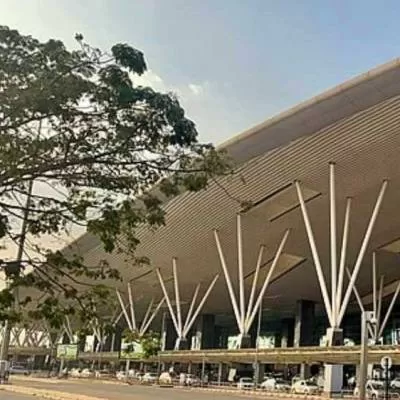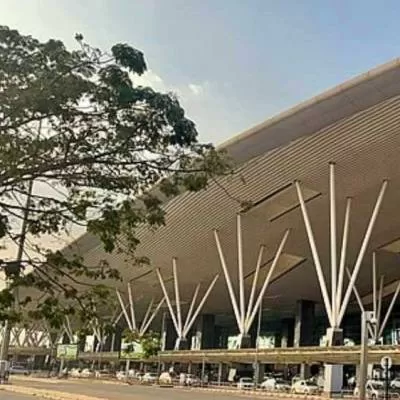- Home
- Infrastructure Transport
- AVIATION & AIRPORTS
- Building for Efficiency

Building for Efficiency
Buildings are by far the largest energy guzzlers, and account for up to 40 per cent of global energy consumption and about one-third of green house gas (GHG) emissions. Against the backdrop of the menacing climatic change owing to increasing GHG effect, saving energy is the prime objective. Effective insulation plays an important role to reduce energy consumption. Ajay Durrani, Managing Director, Indian Sub-Continent, Covestro India, a company that manufactures the raw materials of polymeric building materials, speaks more on the benefits of insulating materials with CW.
Why polymers?
Covestro India, formerly Bayer MaterialScience, has been present in India for over 50 years, offering several solutions to industries including automotive, textile, construction, electronics, etc. We offer two solutions: Polyurethane and polycarbonate. These materials have been available across the world for several decades. For example, Polyurethane has been used in buildings for more than 50 years and utilised in the insulation of roofs in major airports, such as Chicago airport, for over five decades. Foamed polyurethane is a bad conductor of heat; ie it deals with external and internal environment insulating efficiency, which is why it is primarily used in buildings. Similarly, polycarbonate, another type of polymer, is used in buildings for roofing. It is sturdy, lightweight, transparent and extremely tough. These materials, used extensively world over, are now becoming a trend in India as well. And, we are extensively working with governments and appropriate associations to promote the usage of polyurethane as it helps conserve energy in buildings significantly.
The making
Polyurethane is extremely versatile. One of its forms called rigid foam is basically a reaction injection moulded product, which has two major components, polyol and isocyanate, formulated into a system with additives and blowing agents. When these react together, they result in a material that is foamy in nature and can trap gas like carbon dioxide, which makes it light weight and of low thermal mass, which in turn is a feature that works well for an insulation material. It is available in different shapes, thickness and sizes and is extensively used as an insulating panel and can be even sprayed. The thickness and size depend on the efficiency of the foam and the extent to which it can control the impact of external temperature on internal thermal comfort. The material can be used in all types of buildings, with the prime purpose being to insulate.
Advantages
The internal insulating capacity of this material can bring down air-conditioner consumption by almost 30 per cent in a building, which could result to a 25-30 per cent reduction in electricity bills. This could have a significant impact, especially on a society that is moving more towards a controlled environment inside. Further, being lightweight, this technology can be adapted for the affordable housing initiatives through energy-efficient composite panels. Along with being easy to work with, it is also chemical-resistant, rot-proof and emission-free. Because it can be used in different shapes and sizes, polyurethane can be used from the ground and side walls to the roofs and atriums.
The whole concept of smart and green buildings is rooted in what this material can help achieve: Reduction in energy consumption and CO2 level.
So, the bigger agenda is sustainability. Testament to this is the Covestro India Eco-commercial building in Noida, which has been built using this material along with several other green innovations. One of the most efficient zero-emission buildings in Greater Noida, it has received LEED Platinum certification.
Affordability factor
As far as affordability in terms of cost, we need to look at the larger picture as the material can bring down energy cost by 30-50 per cent. Imagine the savings for a call centre setup with a huge insulated area that is able to bring down energy consumption by 30-50 per cent, as well as the impact on the environment with the ability to trap CO2 in the air.
India´s acceptance
In India, many panel manufacturers are using this material and it is also extensively being used in the construction sector. However, though construction is one of the fastest growing markets for us, India still has to realise the true potential of polyurethane as an insulating material. People are looking for smart solutions, and hence, are in greater acceptance of insulating materials. However, there is still a gap in understanding the nature of these insulating materials; to fill this, we need to educate and create awareness. Companies such as Covestro India are committed to make society sustainable. And, while these insulating materials cannot completely change the environment, they can do their bit in reducing energy consumption and CO2.
Insulating materials such as polyurethane and polycarbonate are the absolute solution to reducing energy consumption and CO2 emissions. Buildings are by far the largest energy guzzlers, and account for up to 40 per cent of global energy consumption and about one-third of green house gas (GHG) emissions. Against the backdrop of the menacing climatic change owing to increasing GHG effect, saving energy is the prime objective. Effective insulation plays an important role to reduce energy consumption. Ajay Durrani, Managing Director, Indian Sub-Continent, Covestro India, a company that manufactures the raw materials of polymeric building materials, speaks more on the benefits of insulating materials with CW. Why polymers? Covestro India, formerly Bayer MaterialScience, has been present in India for over 50 years, offering several solutions to industries including automotive, textile, construction, electronics, etc. We offer two solutions: Polyurethane and polycarbonate. These materials have been available across the world for several decades. For example, Polyurethane has been used in buildings for more than 50 years and utilised in the insulation of roofs in major airports, such as Chicago airport, for over five decades. Foamed polyurethane is a bad conductor of heat; ie it deals with external and internal environment insulating efficiency, which is why it is primarily used in buildings. Similarly, polycarbonate, another type of polymer, is used in buildings for roofing. It is sturdy, lightweight, transparent and extremely tough. These materials, used extensively world over, are now becoming a trend in India as well. And, we are extensively working with governments and appropriate associations to promote the usage of polyurethane as it helps conserve energy in buildings significantly. The making Polyurethane is extremely versatile. One of its forms called rigid foam is basically a reaction injection moulded product, which has two major components, polyol and isocyanate, formulated into a system with additives and blowing agents. When these react together, they result in a material that is foamy in nature and can trap gas like carbon dioxide, which makes it light weight and of low thermal mass, which in turn is a feature that works well for an insulation material. It is available in different shapes, thickness and sizes and is extensively used as an insulating panel and can be even sprayed. The thickness and size depend on the efficiency of the foam and the extent to which it can control the impact of external temperature on internal thermal comfort. The material can be used in all types of buildings, with the prime purpose being to insulate. Advantages The internal insulating capacity of this material can bring down air-conditioner consumption by almost 30 per cent in a building, which could result to a 25-30 per cent reduction in electricity bills. This could have a significant impact, especially on a society that is moving more towards a controlled environment inside. Further, being lightweight, this technology can be adapted for the affordable housing initiatives through energy-efficient composite panels. Along with being easy to work with, it is also chemical-resistant, rot-proof and emission-free. Because it can be used in different shapes and sizes, polyurethane can be used from the ground and side walls to the roofs and atriums. The whole concept of smart and green buildings is rooted in what this material can help achieve: Reduction in energy consumption and CO2 level. So, the bigger agenda is sustainability. Testament to this is the Covestro India Eco-commercial building in Noida, which has been built using this material along with several other green innovations. One of the most efficient zero-emission buildings in Greater Noida, it has received LEED Platinum certification. Affordability factor As far as affordability in terms of cost, we need to look at the larger picture as the material can bring down energy cost by 30-50 per cent. Imagine the savings for a call centre setup with a huge insulated area that is able to bring down energy consumption by 30-50 per cent, as well as the impact on the environment with the ability to trap CO2 in the air. India´s acceptance In India, many panel manufacturers are using this material and it is also extensively being used in the construction sector. However, though construction is one of the fastest growing markets for us, India still has to realise the true potential of polyurethane as an insulating material. People are looking for smart solutions, and hence, are in greater acceptance of insulating materials. However, there is still a gap in understanding the nature of these insulating materials; to fill this, we need to educate and create awareness. Companies such as Covestro India are committed to make society sustainable. And, while these insulating materials cannot completely change the environment, they can do their bit in reducing energy consumption and CO2.




















